This list of fast growing vegetables will help you get harvestable produce from your garden in just a few weeks. I include additional tips for having a successful quick growing garden and some of the best varieties of vegetables to grow.

Restless.
That’s how I would describe myself every single spring when I know it’s *almost* time to start digging in the soil.
However, the restlessness is even higher than normal this year due to the current state of our grocery stores. As, I mentioned in a recent podcast episode, NOW is the time for people to start pursuing a more self-reliant lifestyle. No matter where you live, there are things you can do to be prepared and a bit more self-sufficient (not to mention, this is the perfect time to start supporting local farms and strengthen your local food system).
I’m seeing more and more people suddenly interested in becoming more empowered in their food sources. And honestly? I kinda love it.
Suddenly, we’re all researching toilet paper alternatives. And adorable chicks are getting purchased in huge numbers at the feed stores. Learning how to make your own bread is suddenly en vogue. And interest in sourdough has SKYROCKETED, thanks to the yeast disappearing from the stores.
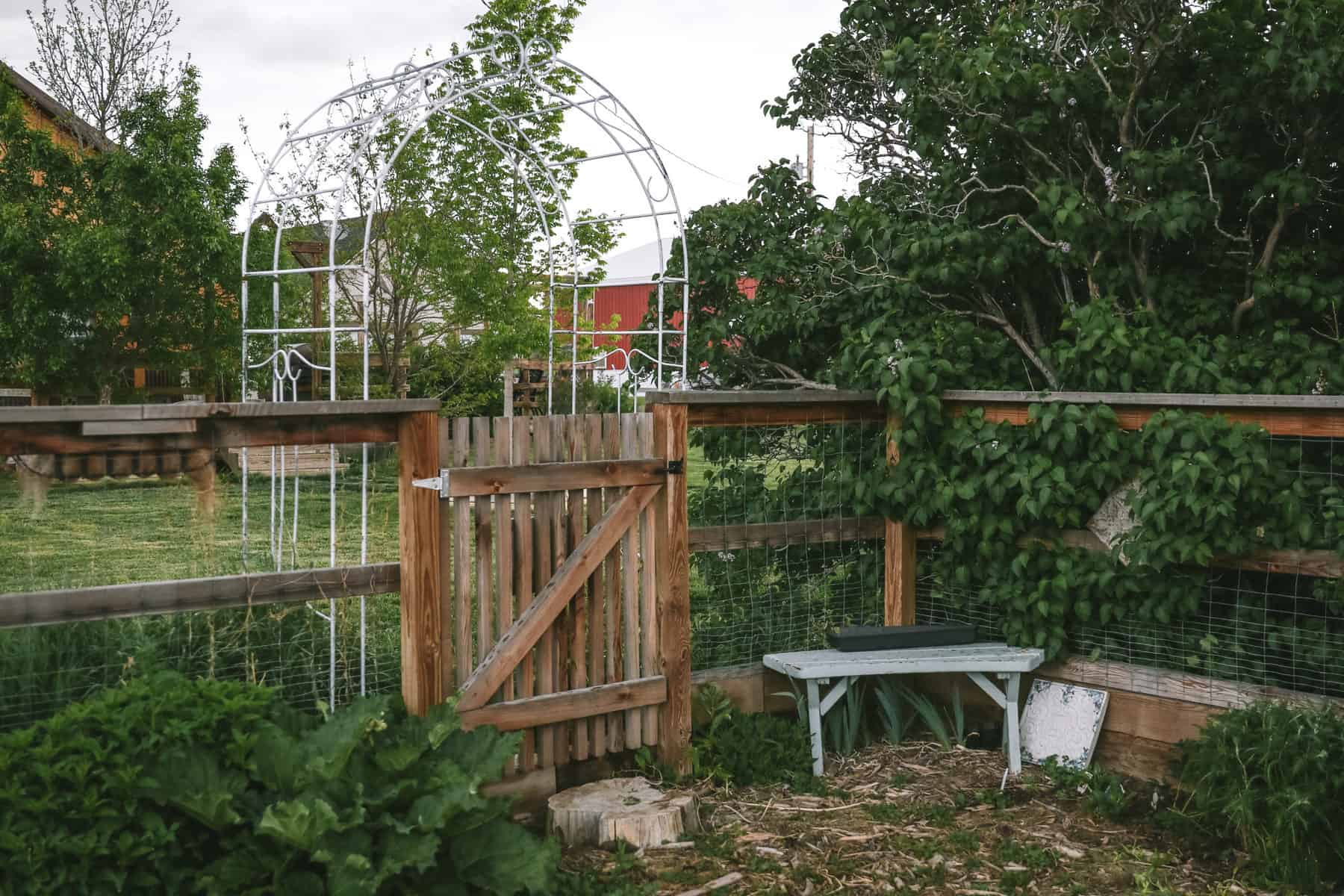
As more folks are feeling the urge to garden this year, seed companies cannot seem to keep up with the requests. If they are even open, stores are selling out of dirt, plants, and seeds. (Fortunately, True Leaf Market, one of my favorite online companies, is still open (currently), so if you’re still looking for seeds, check them out!)
If this is your first year gardening, you might be feeling slightly overwhelmed. If that’s the case, here’s some of my beginner gardening posts that might help you out:
- My seed starting guide will give you general tips for growing all the main vegetable crops.
- My DIY seed starting light setup will help you learn how to start tomatoes and peppers indoors.
- If you have a shady backyard or a shady balcony, here’s a list of vegetables you can grow in the shade.
- Get ahead of weeds right away with my natural weed control tips.
- Be ready for pest problems with my handy organic pest control garden spray recipe.
Since time is of the essence this year, I wanted to put together a list of greens and veggies you can harvest sooner versus later, for a couple of reasons:
First off, the instability of grocery store supply lately is causing many of us to feel the need to grow more food this year, and any veggies we can harvest from our gardens ASAP will only boost our peace of mind.
Secondly, since I garden in a cold climate, and can only grow things from June through September, fast growing vegetables are preferable anyway.
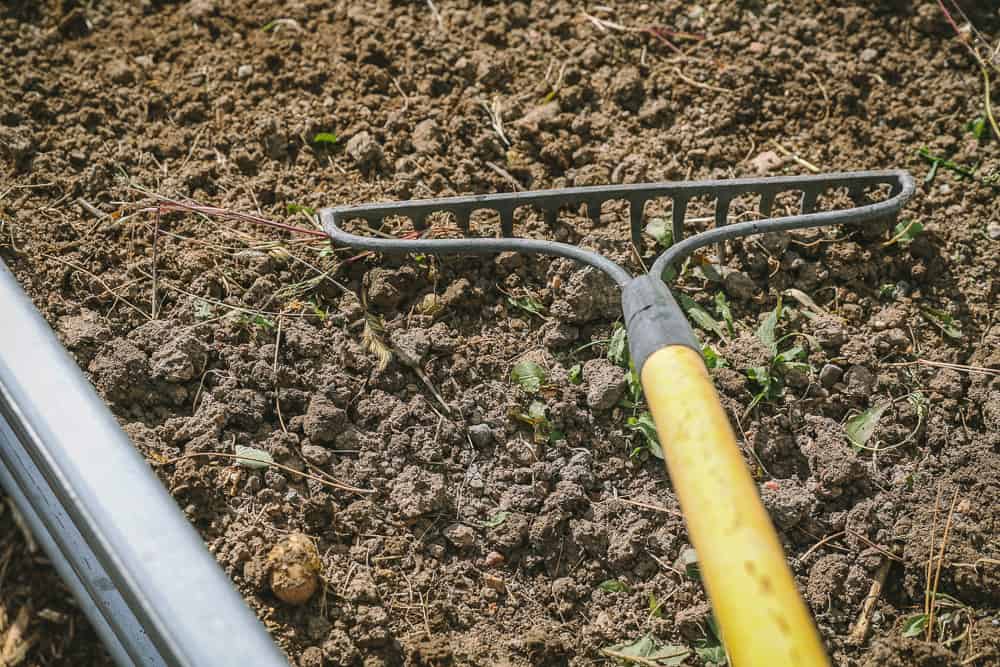
Quick Tips for Fast Growing Vegetables In the Garden
Before we take a closer look at the fastest growing vegetables for your garden, there are a few handy tips to keep in mind that will help you have more success in your garden.
1. Seeds vs. Seedlings.
If you are pushing to get your garden harvestable ASAP, try checking with some small local gardening stores for seedlings or bedding plants. This will be especially helpful with things like tomatoes and peppers, as they need to be started indoors at least 6-8 weeks before your last frost date (learn more here about frost dates and other beginner gardening tips).
However, most of the recommendations in this blog post can be direct-sown in your garden plant– no need to start them indoors or transplant later.
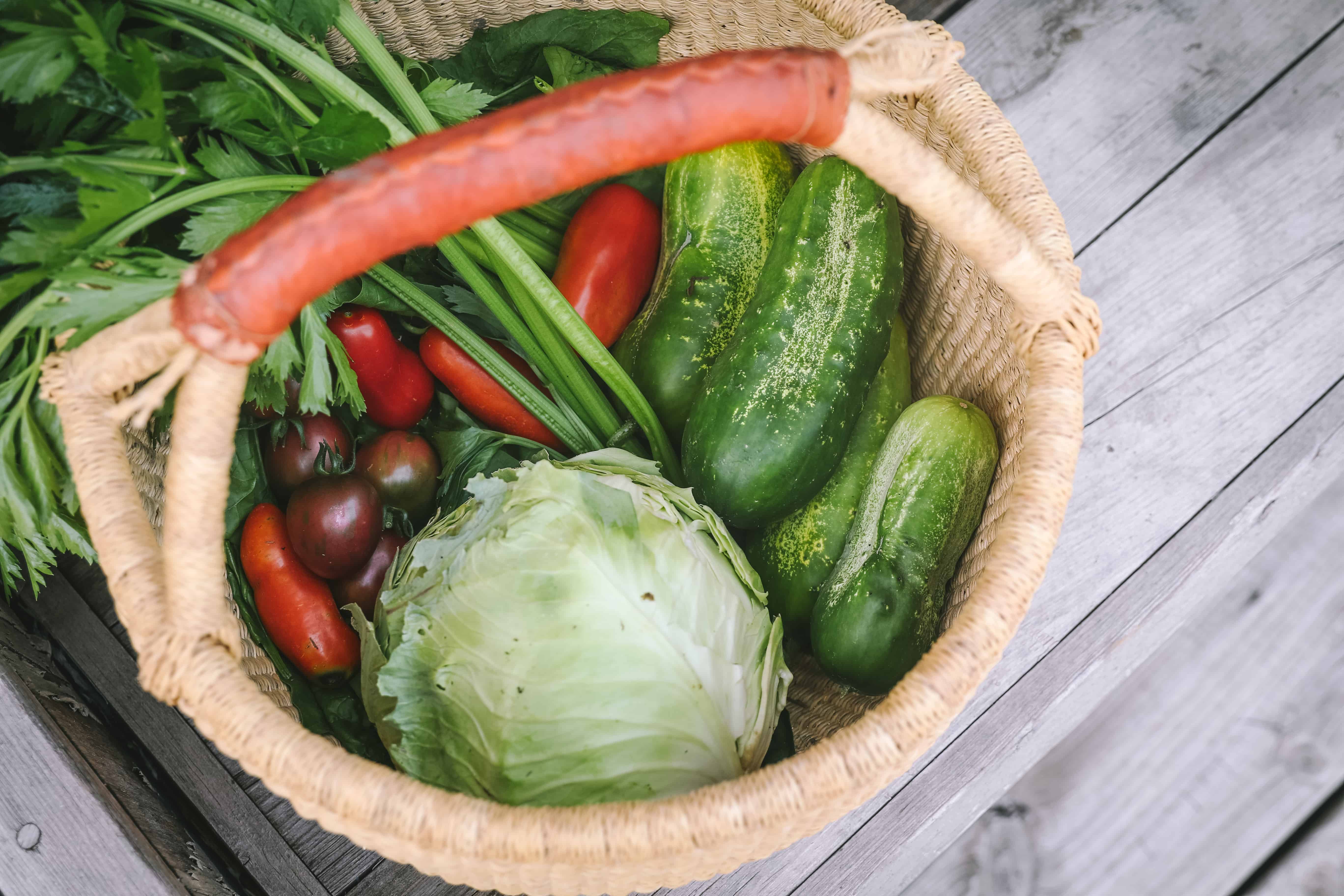
2. Source the Right Vegetable Varieties.
Variety matters when it comes to quick growing vegetables. This is one of the primary reasons I prefer getting my seeds online– I ALWAYS check seed packets and descriptions to see how long it takes for each type to reach maturity. In local garden stores, you may only see the most popular varieties of vegetable seeds, which may or may not work with your climate and might not be fastest growing ones.
If you really want a garden full of harvestable vegetables as soon as possible, seek out the quickest maturing varieties of that particular veggie crop. For example, with carrots– True Leaf Market ‘Little Fingers’ Carrots are ready to harvest in 55 days. Meanwhile, their ‘Tendersweet’ carrot variety is ready to harvest in 75 days.
3. Pick These Vegetables Early.
Part of the reason many of the vegetables mentioned below were chosen for my list of fast growing vegetables is because you can often start harvesting them even earlier than the ‘maturity’ date on the back of the seed packet.
For example, you can probably start picking the kale, lettuce, and other greens earlier than the ‘harvest dates’ on the seed packets say you can harvest. Bonus: greens and many root veggies are even sweeter and more tender if picked when young.
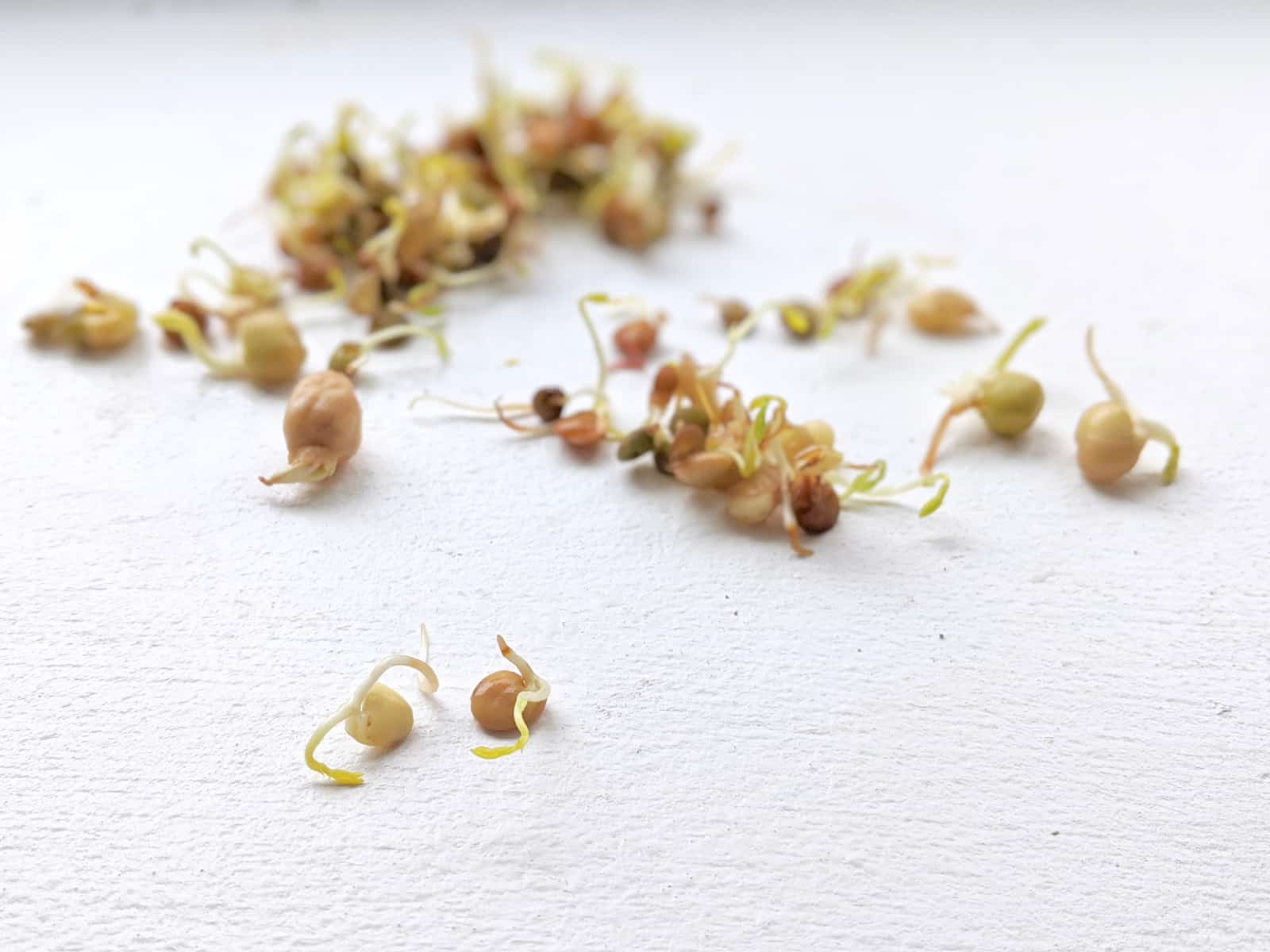
4. Opt for Sprouts or Microgreens Instead.
If you really need some fresh produce in a pinch, try growing sprouts or microgreens! Sprouts are incredibly easy (read my growing sprouts instructions for details). They only take a few days and you have a crunchy and highly-nutritive food for your salads and sandwiches.
5. Good Soil Matters!
No matter how urgently you need your vegetables to be ready to harvest, they won’t grow happy and healthy unless they have a high-quality soil to grow in. Although we personally use raised garden beds for our garden, but you can garden pretty much anywhere (containers, a traditional plot, etc.) as long as you give your plants good soil.
If you’re concerned that your soil may be less than desirable, if may be worth your time to get your garden soil tested so you know what to add to it to give your vegetable crops the nutrients they need. There are plenty of ways to organically improve your soil (here’s a list of ways to improve your soil). At the very least, an application of compost or aged manure can work wonders.
Also- don’t forget a dependable water source (I love soaker hoses or drip irrigation) and direct sunlight (if you can) and you’ll have harvestable veggies in no time.
Fast Growing Vegetables for Your Garden
1. Arugula
Ready to Harvest: approximately 25 days
Arugula is a peppery-flavored green that makes a great addition to your salads. It’s also great as a pesto-type sauce for homemade noodles. Simply direct sow the seeds and you can start harvesting the leaves in about 25-35 days.
It doesn’t care for hot temperatures, so try growing arugula in a shady spot in your garden during the summer months. You can sprinkle some more seeds in the arugula garden bed every few weeks for a constant harvest of arugula greens. Also, if your arugula bolts and flowers, the flowers are edible and make a tasty addition to your salads, too.
2. Asian Greens
Ready to Harvest: approximately 21 days
There are tons of Asian greens for quick growing vegetables for your garden, including Bok Choy, Tatsoi (an Asian spinach), and Mizuna (a Japanese mustard green). These are especially great to plant in early spring and early fall. You can just pick small leaves from most Asian greens around 21 days, or wait 60 days to harvest entire heads of produce.
Bok Choy: A Chinese cabbage that can be used like traditional cabbages (try making sauerkraut with it!) and the smaller leaves can be harvested in about 25 days.
Mizuna: A milder flavored mustard green from Japan, it can grow in the shadier spots in your garden because it only needs 3-5 hours of sunlight to grow. It is ready to harvest in about 21 days.
Tatsoi: An Asian spinach variety that can be harvested in about 35-40 days. The leaves taste more like spinach when they are small, so start picking around that 35 day mark.
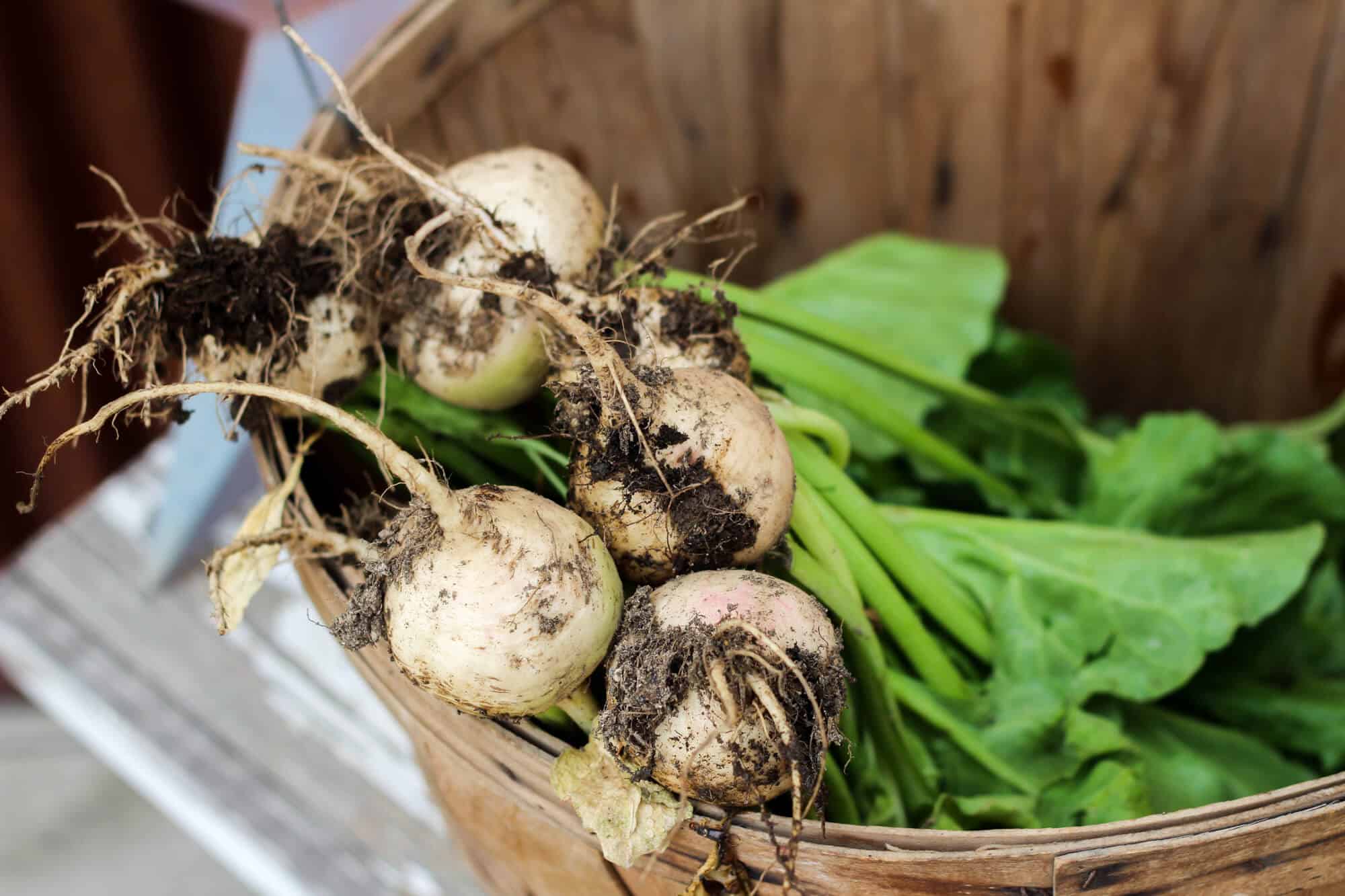
3. Beets
Ready to Harvest: approximately 30 days for leaves or 55 days for beet roots
Beets are a great root vegetable option for a fast growing garden harvest. Whether you love them roasted as a side dish or you love to enjoy pickled beets (here’s a great pickled beets recipe with canning instructions), you can rest assured that you’ll have a harvest sooner rather than later (especailly since young/small beets usually taste better than the matured ones).
Even better, you can enjoy the beet leaves in your salad mixes even earlier. Just don’t harvest all of the leaves in one setting or the root won’t develop. Some varieties of beets mature earlier than others, so watch the labels when you buy your beet seeds! This Early Wonder Beet variety is a great option for your fast growing garden crops.
4. Broccoli
Ready to Harvest: approximately 60 days
You might be surprised to see broccoli on a list of fast growing vegetables. However, there are a few varieties that are quicker to harvest. The most popular quick-growing broccoli variety is Broccoli Raab, also known as Rapini. This is still in the Broccoli family but it produces tiny broccoli shoots that you harvest continually instead of one large head of broccoli.
There are a few standard broccoli varieties that are quick growers too, but you usually end up with multiple smaller heads of produce instead of one large one. What’s even better about growing broccoli is they can stand colder temperatures and a few frosts, so it’s a great early spring vegetable to grow, even in cold climates like here in Wyoming.
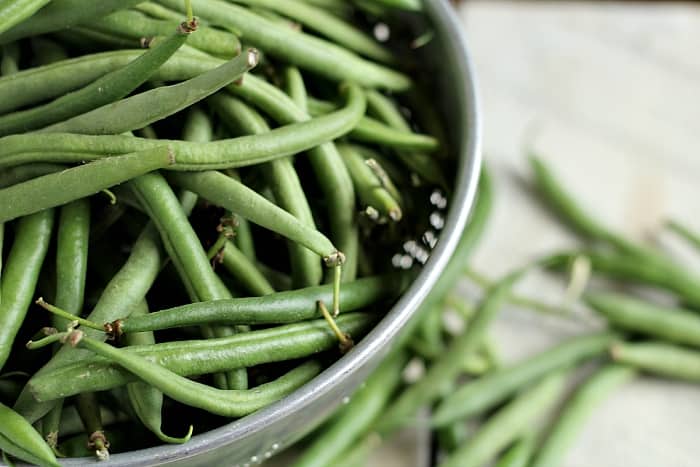
5. Bush Beans
Ready to Harvest: approximately 50-60 days
Beans are one of the easiest crops to grow, so they’re perfect for beginner gardeners. Just give ’em full sun and some daily watering and watch for some pests, and you should get a pretty decent crop. Bush beans are quicker to be ready to harvest than the pole bean varieties and they can produce tons of food for your family.
As long as you keep picking the beans, the plants can produce lots of food for you. When we can’t keep up with eating them fresh, I love preserving the extras by freezing them for later use or making pickled green beans. Yum.
If you plant more bean seeds about 14 days after the first ones are sown, you can extend your bean harvest farther into the summer, which really helps stock up the freezer for the winter.
6. Carrots
Ready to Harvest: approximately 55 days
Carrots are usually not the quickest vegetable to grow, however, if you choose the correct varieties and you harvest them while they are still small, you can enjoy carrots in about 55 days. And bonus: the baby carrots are often sweeter than when you allow them to mature. Choose a variety like Little Fingers carrots, which are supposed to stay small anyway and are one of the quicker varieties of carrots to grow.
Another great thing about growing carrots for your fast growing vegetable patch is that you can eat the carrot tops, too. They make a great pesto-type sauce or use the young carrot tops as a substitute for parsley in your recipes.
7. Cress
Ready to Harvest: approximately 15 days
Cress is a peppery-tasting green that you can grow in your garden for a super quick crop. You can start harvesting the leaves when the plant is only 2 inches tall. It makes a great microgreen or sprouts option as well. The one downside is that cress does not like heat, so grow this in your early spring and then again in the fall.
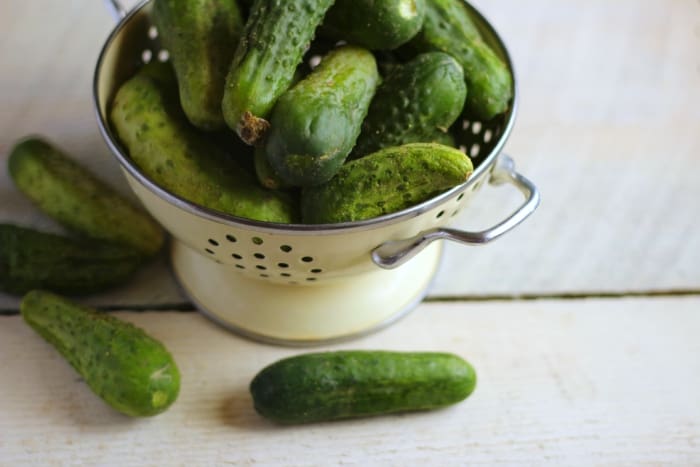
8. Cucumbers
Ready to Harvest: approximately 55 days
Cucumbers are a great versatile vegetable for growing in your garden. You can grow the ‘slicing’ varieties for cucumbers on your salads or the ‘pickling’ varieties and preserve them by either canning them, making quick pickles, or fermenting them (my favorite way to preserve pickles!). Alot of people have issues with getting crunchy and crispy homegrown pickles, but don’t worry, I’ve got plenty of great tips for getting crunchy pickles.
It’s best to grow cucumber plants on trellises if you can, since they like to sprawl. Harvest both varieties of cucumbers early for more sturdy produce. Make sure you pay attention to the varieties you choose, since some varieties take longer before harvest than others.
9. Green Onions
Ready to Harvest: approximately 60 days
Green onions are a quick growing onion that resembles a thicker-stemmed chive. You can start harvesting the tender young green stalks around 60 days and you can usually get a few harvests from the same plant.
10. Kale
Ready to Harvest: approximately 40-50 days
Kale is a hearty and cold-tolerant plant for your quick-growing garden. If you want mature kale leaves, you need to wait at least 40-50 days before harvesting (depending on the variety). Baby kale leaves can start being picked as early as 25 days. As long as you pick only some leaves from each plant, kale plants can produce leaves for almost the entire gardening season.
There are tons of different varieties of kale, not just the curly-leaf type you remember as a garnish on the side of your plate at restaurants. So have some fun trying all sorts of types of kale to find your family’s favorite.
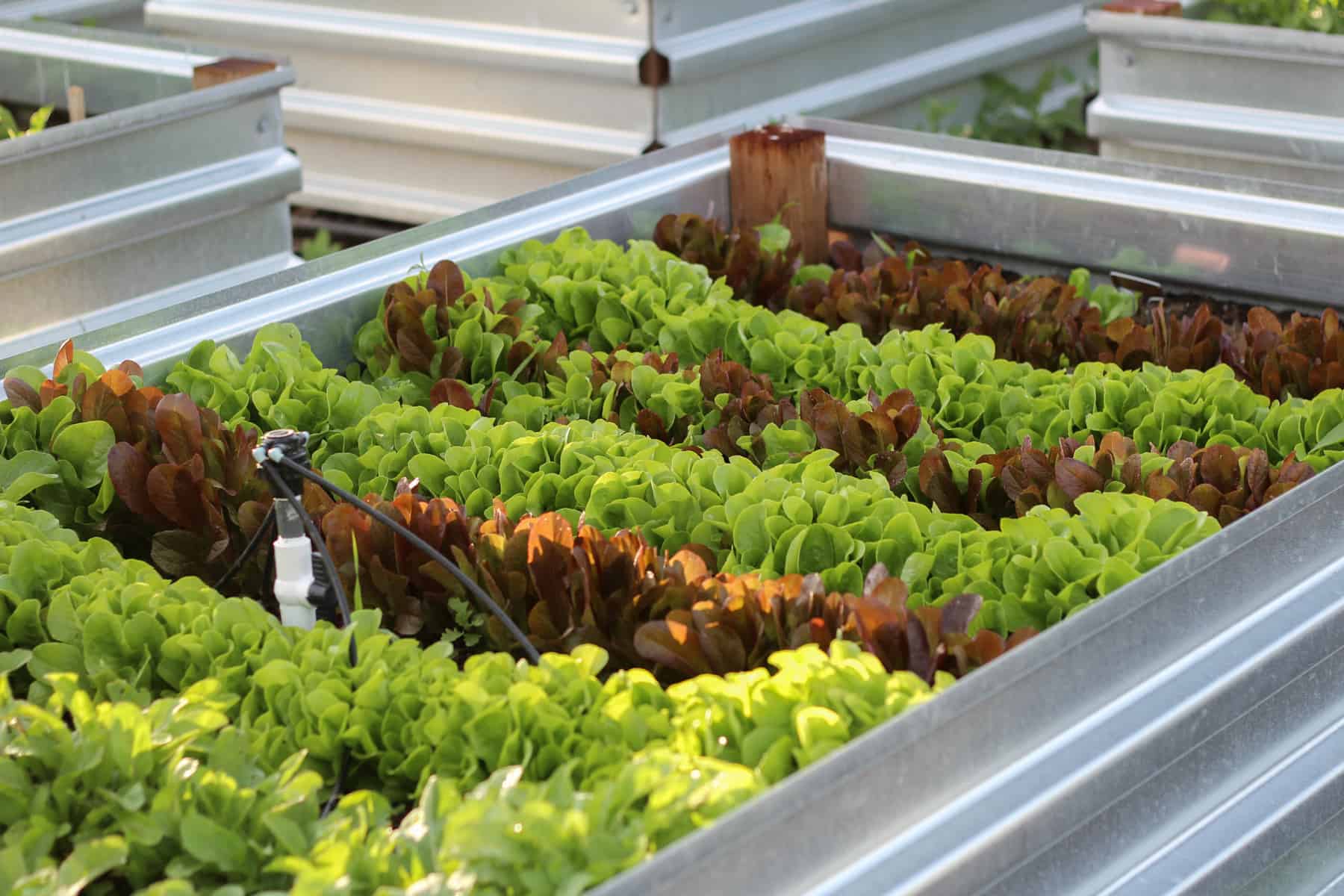
11. Lettuce
Ready to Harvest: approximately 30 days
Lettuce greens are an incredibly versatile plant for your garden. There are so many varieties to choose from. They are pretty easy to grow and, depending on the variety you choose, you can get some lettuce varieties ready in only 30 days.
As long as you harvest only a few leaves from each lettuce plant (start with the exterior leaves), your lettuce plants can last a long time into the gardening season. Choose a variety that’s best for your gardening climate if you can. Some types will bolt in heat quicker than others. Most lettuces are quite hardy in cold climates.
12. Mustard Greens
Ready to Harvest: approximately 30 days
Mustard greens can give your fresh salads a tasty spicy kick. I also love them sauteed with bacon as a side dish. Tney are easy to grow, though they bolt in hot weather in a similar way as lettuce greens. The baby mustard green leaves are ready to harvest in just 30 days and the mature leaves in about 40. If you just harvest a few leaves from each plant, they can last longer in your gardening season.
13. Okra
Ready to Harvest: approximately 50 days
You either love or hate okra. If you love it, you’ll be delighted to know that it’s a quick growing vegetable option for your garden. Each plant will give you lots and lots of okra, so you don’t make the rookie mistake of planting a huge bed of them (unless you really love them).
In just 50 days, you’ll start harvesting okra for your favorite meals. Fried okra is a popular dish, and many people use them in stews or soups, too.
14. Peas
Ready to Harvest: approximately 55 days
Peas are easy to grow in the garden, however, it does take quite a few plants to get a decent side dish of peas for dinner. They also prefer cooler weather, so you can expect a crop in early spring and then the plants are done growing once the summer heat starting rolling in.
One nice thing is that you can eat either the pea pods OR you can eat the pea shoots. So if your pea crop doesn’t look like it’s gonna come in before the summer heat turns up, you can always just harvest the pea shoots and eat them instead. They taste like the peas and you can saute them in butter for a simple side dish.
15. Radishes
Ready to Harvest: approximately 25 days
If you’ve only ever had the generic radishes from the grocery store, I strongly encourage you to try growing your own. Homegrown radishes, especially if picked early, are crunchy and pleasant-tasting additions to your salads. They are one of the quickest vegetables to be ready to harvest in your garden.
There are tons of varieties, some are even white and look more like carrots than your traditional radish types. Some radish varieties are sweet instead of spicy, too, so have fun with your selections! Radishes are very easy to grow, so they are perfect for beginner gardeners or in a kids’ garden.
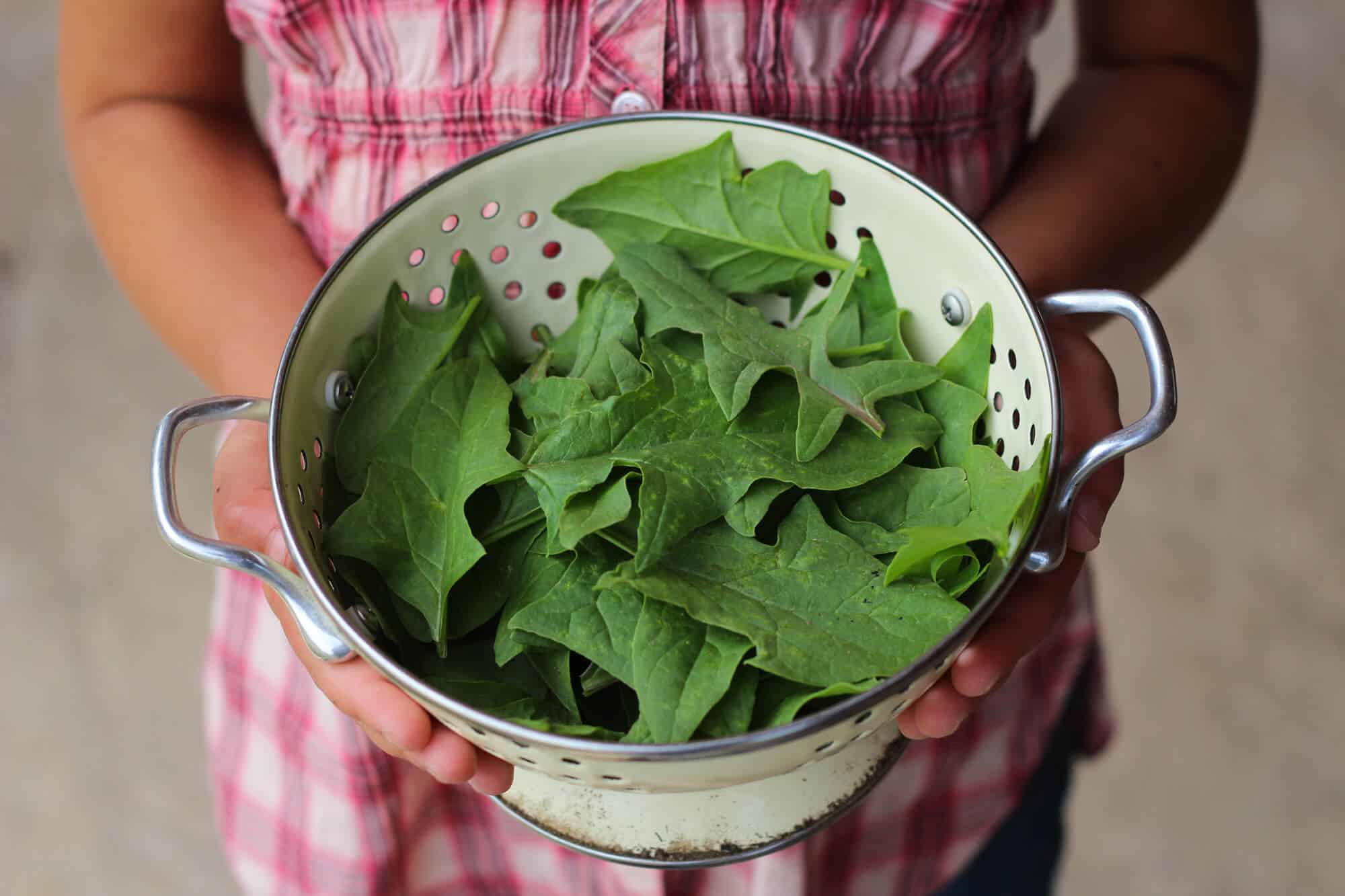
16. Spinach
Ready to Harvest: approximately 30 days
Spinach is easy to grow and is another great greens option to grow in your quick growing garden this year. Some spinach varieties are ready to harvest in just 30 days. You can grow spinach in part shade, which is preferred since it bolts easily in hot weather. I love that you can eat spinach in salads, sauteed as a side dish, or put it in smoothies, too. It’s a great versatile veggie for recipes!
17. Summer Squash and Zucchini
Ready to Harvest: approximately 45-50 days
If you choose the early varieties and pick them while they are young, summer squash and zucchini are the perfect crops for your fast growing garden. They love warm soil, so you should plant them for a summer crop.
They are usually pretty easy to grow, and each plant will give you tons of produce (did you know there’s a holiday on August 8 known as “National Sneak Some Zucchini onto Your Neighbor’s Porch Day”?). You can also eat the flowers, which are great stuffed or fried.

18. Turnips
Ready to Harvest: approximately 45 days
Turnips are an easy growing root vegetable, and, depending on the variety, can be ready to eat in around 45 days. They are very non-fussy and can be grown in both cold and warm climates pretty easily. Harvest them when they are kinda small if you want sweet and tender turnips.
A bonus is that turnip greens are also edible and pretty darn delicious. The greens are super tasty when sauteed with bacon (I mean, everything is better with bacon, ya know?).
My Final Thoughts on Fast Growing Garden Vegetables
Gardening is a roller coaster. It’s likely your season (and mine) will be filled with victories and disappointments, but don’t let that deter you. Not for a second. Whether you’re growing in containers on your deck or a half-acre plot, I’m rooting for you. Every step you make towards taking charge of your own food supply is a WIN and it matters. You got this!
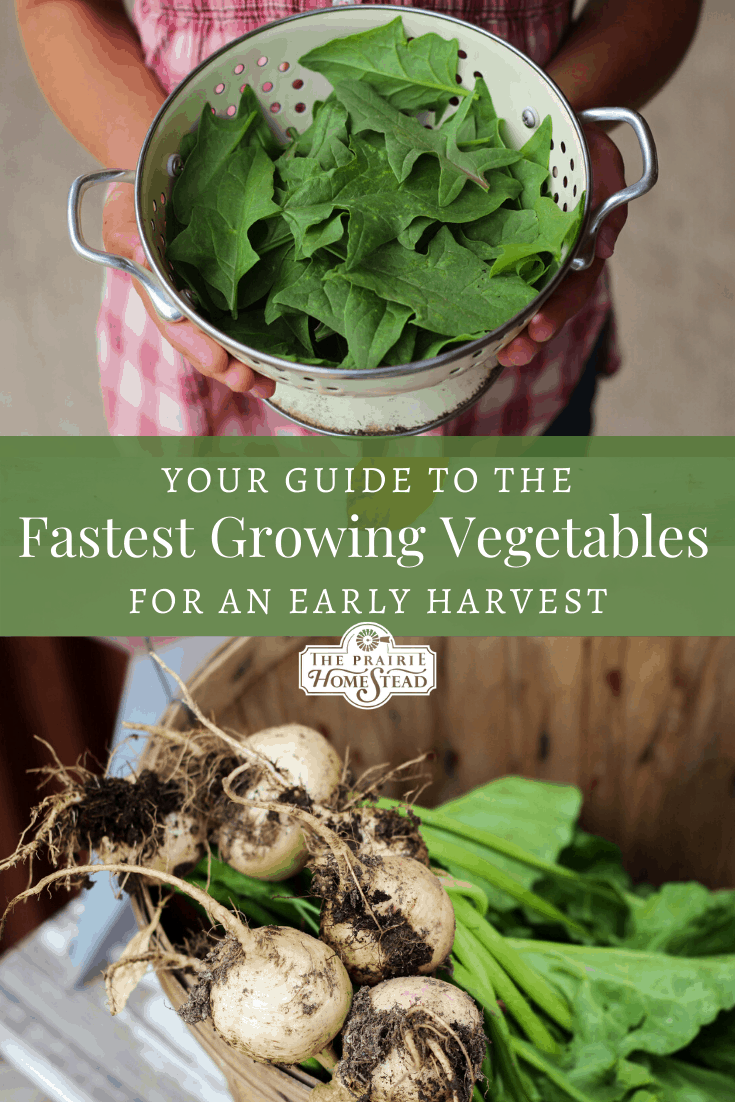
Preserving Food Tips:
- My Canning Made Easy System (learn my best tips for easy canning in your kitchen)
- A Guide to Quick Pickled Vegetables
- How to Preserve Herbs in Oil
- Root Cellar Alternatives
The post Fast Growing Vegetables to Grow for an Early Harvest appeared first on The Prairie Homestead.
Via Gardening http://www.rssmix.com/
No comments:
Post a Comment